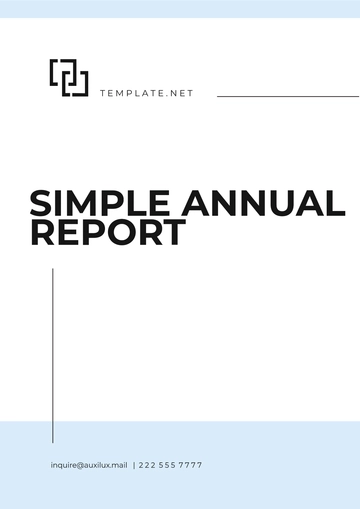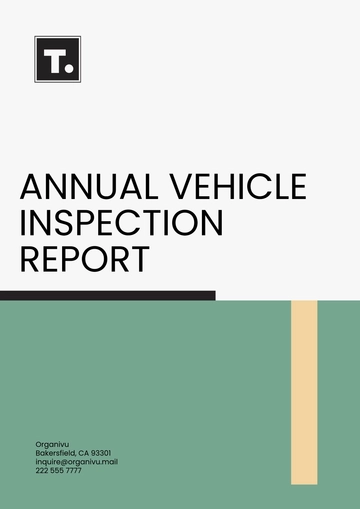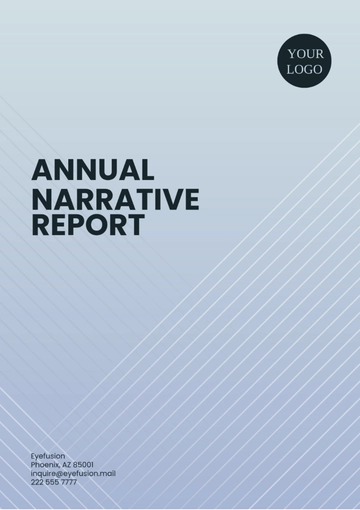Free Agency Financial Report

I. Introduction
Welcome to [YOUR COMPANY NAME]'s Agency Financial Report (AFR) for the fiscal year ending September 30, 2050. This report provides a comprehensive overview of our agency’s financial performance, strategic planning initiatives, and operational accomplishments.
Prepared by:
[YOUR NAME]
[YOUR COMPANY NAME]
[YOUR EMAIL]
[YOUR COMPANY NUMBER]
[YOUR COMPANY ADDRESS]
II. Management’s Discussion and Analysis
A. Overview of the Agency
[YOUR COMPANY NAME] is committed to delivering high-quality services and achieving our strategic goals efficiently and effectively. Our mission is to provide exemplary public service and to steward taxpayer resources responsibly. We operate across various sectors including healthcare, education, and infrastructure, aiming to improve the quality of life for all citizens.
B. Financial Highlights
For the fiscal year 2050, our agency reported total assets of $10 billion, total liabilities of $4 billion, and net position of $6 billion. Key financial outcomes include:
Metric | Amount |
|---|---|
Revenue | $15 billion |
Expenditures | $14 billion |
Net Operating Cost | $1 billion |
These financial highlights reflect our commitment to fiscal responsibility and effective management of resources. We have seen significant growth in our revenue streams, primarily driven by increased federal funding and the successful implementation of cost-saving measures.
C. Performance Goals and Results
Our agency set forth several strategic goals for fiscal year 2050, focusing on enhancing service delivery, improving operational efficiency, and strengthening internal controls. Notable achievements include:
Description | Result |
|---|---|
Implement a new digital service platform to improve user access and satisfaction. | Successfully launched the platform, resulting in a 25% increase in user engagement. |
Reduce operational costs by 10% through process optimization. | Achieved a 12% reduction in costs, saving $1.2 billion. |
Enhance workforce training programs to boost employee productivity. | Conducted training sessions for over 5,000 employees, resulting in a 15% increase in productivity. |
III. Financial Statements
A. Balance Sheet
Assets
Category | Amount |
|---|---|
Current Assets | $5 billion |
Non-Current Assets | $5 billion |
Total Assets | $10 billion |
Liabilities
Category | Amount |
|---|---|
Current Liabilities | $2 billion |
Long-Term Liabilities | $2 billion |
Total Liabilities | $4 billion |
Net Position
Category | Amount |
|---|---|
Unrestricted Net Position | $4 billion |
Restricted Net Position | $2 billion |
Total Net Position | $6 billion |
B. Statement of Net Cost
Program Costs
Category | Amount |
|---|---|
Program 1 | $5 billion |
Program 2 | $4 billion |
Program 3 | $5 billion |
Total Program Costs | $14 billion |
Net Cost of Operations
Category | Amount |
|---|---|
Total Costs | $14 billion |
Total Earned Revenue | $13 billion |
Net Cost of Operations | $1 billion |
C. Statement of Changes in Net Position
Category | Amount |
|---|---|
Beginning Net Position | $5 billion |
Budgetary Financing Sources | $2 billion |
Other Financing Sources | $0.5 billion |
Net Cost of Operations | $1 billion |
Ending Net Position | $6 billion |
IV. Strategic Planning
A. Vision and Mission
Our strategic planning for the fiscal year 2050 was guided by our vision to be a leader in public service innovation and our mission to deliver high-quality, efficient, and accountable services to the public.
B. Key Strategic Initiatives
Initiative | Objective | Description |
|---|---|---|
Digital Transformation | Enhance digital service delivery to improve user experience. | Implementation of new digital platforms, upgrading existing systems, and staff training. |
Operational Efficiency | Optimize resource utilization to maximize operational output. | Process reengineering, cost-saving measures, and performance monitoring. |
Stakeholder Engagement | Strengthen communication and collaboration with stakeholders. | Regular stakeholder meetings, surveys, and feedback mechanisms. |
C. Future Goals
Looking ahead, our strategic goals include:
Enhanced Service Delivery: Continue to innovate and improve service offerings. We plan to expand our digital services, making them more accessible and user-friendly.
Sustainability: Implement eco-friendly practices and promote sustainability. We aim to reduce our carbon footprint by adopting green technologies and promoting sustainable practices within our operations.
Workforce Development: Invest in employee training and development to build a skilled and motivated workforce. Our goal is to foster a culture of continuous learning and professional growth.
V. Internal Controls and Compliance
A. Internal Controls
Our agency maintains a robust internal control system designed to ensure the integrity of financial reporting, compliance with laws and regulations, and the effective and efficient operation of our programs. We regularly review and update our internal controls to address new risks and challenges, ensuring that we remain compliant with federal standards.
B. Compliance
During the fiscal year 2050, we complied with all relevant financial management regulations, including the Federal Managers’ Financial Integrity Act (FMFIA) and the Federal Financial Management Improvement Act (FFMIA). Our commitment to compliance is demonstrated through rigorous internal audits and external reviews, which help us identify areas for improvement and implement corrective actions promptly.
VI. Conclusion
[YOUR COMPANY NAME] is proud of our accomplishments in fiscal year 2050 and remains committed to continuous improvement and excellence in public service. This Agency Financial Report demonstrates our dedication to transparency, accountability, and strategic planning to achieve our mission and vision.
- 100% Customizable, free editor
- Access 1 Million+ Templates, photo’s & graphics
- Download or share as a template
- Click and replace photos, graphics, text, backgrounds
- Resize, crop, AI write & more
- Access advanced editor
Unlock the potential of your financial reporting with our Agency Financial Report Template from Template.net. This highly customizable and editable template ensures your reports are comprehensive and professional. Seamlessly designed for efficiency, it integrates with our advanced AI Editor Tool, allowing you to tailor every detail to meet your agency’s specific needs.
You may also like
- Sales Report
- Daily Report
- Project Report
- Business Report
- Weekly Report
- Incident Report
- Annual Report
- Report Layout
- Report Design
- Progress Report
- Marketing Report
- Company Report
- Monthly Report
- Audit Report
- Status Report
- School Report
- Reports Hr
- Management Report
- Project Status Report
- Handover Report
- Health And Safety Report
- Restaurant Report
- Construction Report
- Research Report
- Evaluation Report
- Investigation Report
- Employee Report
- Advertising Report
- Weekly Status Report
- Project Management Report
- Finance Report
- Service Report
- Technical Report
- Meeting Report
- Quarterly Report
- Inspection Report
- Medical Report
- Test Report
- Summary Report
- Inventory Report
- Valuation Report
- Operations Report
- Payroll Report
- Training Report
- Job Report
- Case Report
- Performance Report
- Board Report
- Internal Audit Report
- Student Report
- Monthly Management Report
- Small Business Report
- Accident Report
- Call Center Report
- Activity Report
- IT and Software Report
- Internship Report
- Visit Report
- Product Report
- Book Report
- Property Report
- Recruitment Report
- University Report
- Event Report
- SEO Report
- Conference Report
- Narrative Report
- Nursing Home Report
- Preschool Report
- Call Report
- Customer Report
- Employee Incident Report
- Accomplishment Report
- Social Media Report
- Work From Home Report
- Security Report
- Damage Report
- Quality Report
- Internal Report
- Nurse Report
- Real Estate Report
- Hotel Report
- Equipment Report
- Credit Report
- Field Report
- Non Profit Report
- Maintenance Report
- News Report
- Survey Report
- Executive Report
- Law Firm Report
- Advertising Agency Report
- Interior Design Report
- Travel Agency Report
- Stock Report
- Salon Report
- Bug Report
- Workplace Report
- Action Report
- Investor Report
- Cleaning Services Report
- Consulting Report
- Freelancer Report
- Site Visit Report
- Trip Report
- Classroom Observation Report
- Vehicle Report
- Final Report
- Software Report





























